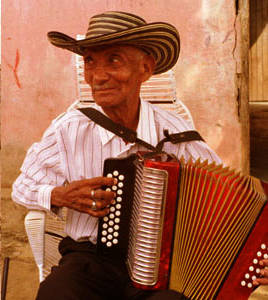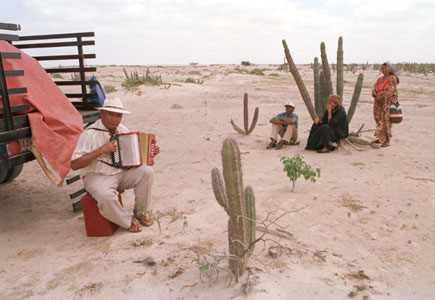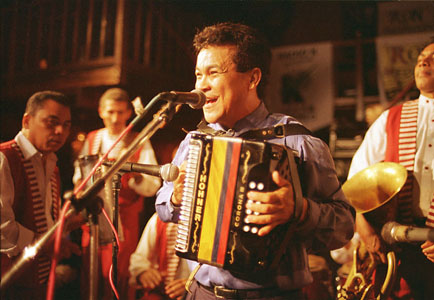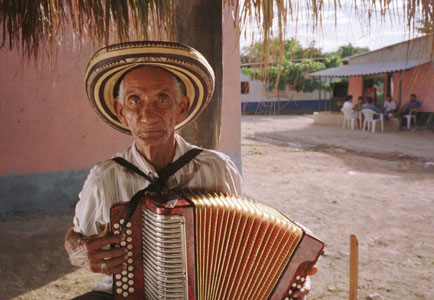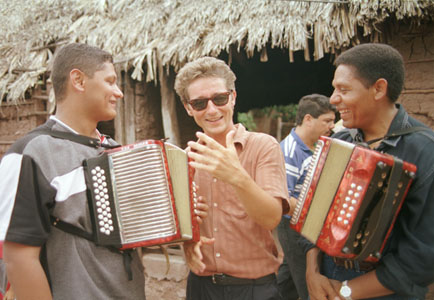
El Acordeon del Diablo
Ein Film für alle Hohner Corona-Freunde: Die Kolumbianer entlocken diesem Instrument völlig andere Klänge als man gewohnt ist - sie haben die diatonische Handharmonika neu erfunden. In Kolumbien spielt man die Hohner Corona III und zwar in B-Es-As (BbEbAb) Stimmung, wegen eben dieser fünf Buchstaben, die ins Holz des Instruments eingeschlagen sind, auch "cinco letras" Fünf Buchstaben genannt. Von ortsansässigen Instrumentenbauern wie Ovidio Granados lassen die Spieler die Instrumente dann höher stimmen auf H E A. Außerdem wird das Tremolo, das ab Werk alpenländisch ausfällt, abgemindert, harmonischer gemacht, wie die Spieler sagen. All dies ist schön zu sehen in der Szene In der Akkordeon-Werkstatt.
Filme, in denen karibische Musik im Mittelpunkt steht, sind immer auch Geschichten von Menschen. Nicht im Sinne von Folklore, sondern von Leben, oder besser: von Lebenskunst. Der schöne, relaxed fabulierte Film von Stefan Schwietert zeigt beeindruckend, wie die Musik so ganz einfach und lustvoll zum Leben gehören kann wie Essen, Trinken, Schlafen, Lieben. Alle, die dies alles gern tun, werden sich in diesem Film wohlfühlen. Die Szene ist diesmal Kolumbien, nicht das modische Kuba. Schwieterts Film entwirft das bemerkenswerte Porträt eines phänomenalen 92-jährigen Kolumbianers, der ein Jahr nach den Dreharbeiten mutig eine dritte Ehe eingegangen ist. Im Film rühmt sich dieser Pacho Rada, dessen in Buchform erschienene Lebensgeschichte den Regisseur inspirierte, wie in kindlicher Freude čber ein gewonnenes Spiel seiner insgesamt 422 Enkel, Ur- und Ururenkel. Aber vor allem erzählt er, ganz in der Tradition der karibischen Volkserzähler, wie er zur Musik und vor allem zum Akkordeon gekommen ist, das eigentlich im Ambiente der Maracas, Timbales, Gitarren, des Steel- und Bläser-Sound eher ungewöhnlich ist. Als vierjähriger Bub bekam Pacho Rada ein Akkordeon von seinem Vater geschenkt, der einer der ersten Kolumbianer mit diesem Instrument war. Deutsche Matrosen hatten es ihm verkauft. Seit Mitte der 19. Jahrhunderts hielt die Ziehharmonika per Schiff Einzug in Kolumbien. Es ist schwer vorstellbar, dass ein Musiker wie Pacho, der als fast klassischer Troubadour in seiner Jugend durch das Land gezogen war und allein zum Akkordeon gesungen hatte, heute in seiner selbst gebauten Wellblechhütte im Küstendorf Santa Marta lebt. Obwohl seine Kompositionen inzwischen andere Musiker spielen und singen und Karriere damit machen. Obwohl er, neben anderen Akkordeonspielern, den Autor Gabriel Garcia Marquez zu einer Romanfigur in 'Hundert Jahre Einsamkeit' inspirierte. Sozialkritik oder politische Statements sind jedoch Schwieterts Sache nicht. Ihm geht es in seinem Film um Beobachtung und Beschreibung, mit viel Liebe und Respekt für die Menschen und deren Phantasie, Kreativität und Lebensfreude. Und da geht von den Bildern (Kamera: Ciro Capellari) und der Musik eine mitreißende Authentizität aus, wie man sie im Kino selten erlebt. Pacho spielt heute zwar nicht mehr so oft, aber wenn, dann muss man einfach seine Fingerfertigkeit und die Klänge seiner Hohner-Harmonika bestaunen. Vallenato, das war einst die Musik der armen Leute, bis in den 70er Jahren die Drogenbarone sie entdeckten und auch kommerziell erfolgreich machten. Son, Cumbia, Paseo und auch die dominikanische Merengue - Pacho Rada beherrscht sie alle und hat sein Talent an den Sohn weitergegeben. Die Sinnlichkeit und Emotionalität der Musik und der Mensch atmet animierend auch dieser schöne Film.
Die Seite zum Film: www.acordeon.de Watch the trailer, in Real Player format: http://www.acordeon.de/video/trailer.ram [URL=http://www.acordeon.de/english/1_film/1_5_video.htm]Go to this page for the trailer of this film[/URL]
Pacho Rada EL ACORDEÓN DEL DIABLO tells the story of that great old man of Caribbean music, Pacho Rada. It is the tale of a singer and composer who first held an accordion at the age of four and was never to let go of it again. A man who throughout his life travelled around Colombia, moving from village to village and from party to party, singing and playing for a few centavos. He's 93 now and lives in a corrugated iron shack on the outskirts of Santa Marta in Colombia, whilst his songs climb up the hit parades.
[IMG]http://www.peterunbehauen.de/BilderFolk/05pu/72photo3.jpeg[/IMG] Alfredo Gutierrez The musician who transformed Colombian Cumbia and bullfight tunes into a fiery big band sound, Alfredo Gutierrez, also performs in the film. [IMG]http://www.peterunbehauen.de/BilderFolk/05pu/72photo5.jpeg[/IMG] El Morré, Stefan Schwietert and Israel Romero And then there is the undisputed star, Israel Romero, king of Vallenato, hurling himself into a breathtaking virtuoso accordion duel with his nephew El Morré. Although Pacho Rada is one of the founding fathers of Caribbean music, he actually became famous through a book. Gabriel Garcia Marquez paid tribute to him in the novel, "One Hundred Years of Solitude". [IMG]http://www.peterunbehauen.de/BilderFolk/05pu/72photo2.jpeg[/IMG] Pacho RadaŽs son The figure of the troubadour, Francisco El Hombre, who one night has a fateful encounter with the devil, is modelled on Pacho Rada. In an accordion duel fought out to the bitter end, the troubadour gets the better of the devil and saves his own soul. The boundaries between dream and reality are blurred in Pacho Rada's tales, just as they are in Marquez's novels. [IMG]http://www.peterunbehauen.de/BilderFolk/05pu/72photo4.jpeg[/IMG] Pacho Rada The daily struggle to survive in Colombia is just as real to Pacho Rada as fables and fairy tales. The film enters into both these universes with him, exploring a country torn asunder by poverty and violence and a fantastic realm of legends and captivating music. The Musicians Francisco ?Pacho' Rada Pacho Rada was born on May 11th 1907 in Las Mulas, on the great Magdalena river. European ships from have travelled along the river since the mid-19th century and this is where Pacho's father bought an accordion from German sailors, becoming one of Columbia's first accordionists. Alfredo Gutierrez Alfredo de Jesús Gutiérrez was born on April 17th 1944 in Paloquemao, Sucre. His work as a song-writer and composer gave a boost to the position of folk music in his country. He ranks among the country's greatest musicians, thrice crowned Vallenato King, having won the competition and been voted best accordionist at the Vallenato festival held every year in Valledupar. Manuel Rada Oviedo and Rafael Valencia Manuel Rada is Pacho Rada's youngest son. He travels around the country just like his father used to, together with his cousin, Rafael Valencia, living on whatever he can earn here and there for performing. There are no records of his music, he doesn't appear on television but plays at parties and other festive occasions or throws an ad-hoc concert in his neighbourhood when the mood takes him. Israel Romero and José ?Morre' Romero Israel Romero is the accordionist with the most successful Vallenato pop-band "BINOMINO DE ORO" and is also one of its founders. The band, which he set up with singer Rafael Orozco in 1976, soon began to perform with two accordions, choristers, synthesisers and electrical guitars. They produced a series of platinum hits after another and appeared in huge sports stadiums with their top-notch show. In 1993 the group's singer, Rafael Orozco, was killed in a mafia shooting, having become embroiled in illegal deals with them. Since then Israel has lead the band on his own. Antonio Jamarillo, ?Perro Negro' Antonio Jamarillo lives in Aracataca, birthplace of Gabriel Garcia Marquez. He is Aracataca's carpenter and is also reputed to have links with the devil, for all women succumb to his charms. He only plays music for the fun of it, with a bottle of rum always by his side. His melodies for two guitars have their roots in Cuba. There was an influx of Cuban migrant workers in Columbia in the thirties, and they brought Cuban son with them. That in turn became the basis underpinning Columbian son. DIRECTOR BIOGRAPHY Stefan Schwietert was born 1961 in Esslingen, Germany. He grew up in Basel, Switzerland. From 1981 to 1982, he lived in Brazil where he worked for TV Globo in the area of music films. In 1982, he received a guest scholarship at the California Art Institute in San Francisco where he studied Film and Video. From 1984 to 1990, he attended the German Film and Television Academy Berlin, where he made various short films and his first feature length film. He is founder of the production company Neapel Film in Basel, Switzerland which has produced some Swiss short films and Schwietert¥s own films in international co-production. Mirar el acoplado, en formato verdadero del jugador: http://www.acordeon.de/video/trailer.ram [URL= http://www.acordeon.de/english/1_film/1_5_video.htm] ir a esta página para el acoplado de esta película [/URL]
Pacho Rada EL ACORDEÓN DEL DIABLO cuenta la historia de ese gran viejo hombre de la música del Caribe, Pacho Rada. Es el cuento de un cantante y de un compositor que primero sostuvieron un acordión en la edad de cuatro y era nunca dejó para ir de él otra vez. Un hombre que a través de su vida viajó alrededor de Colombia, moviéndose desde aldea a la aldea y desde partido al partido, cantando y jugando para algunos centavos. Él ahora es 93 y vive en un shack del hierro acanalado en las cercanías de Papá Noel Marta en Colombia, mientras que sus canciones suben encima de los desfiles del golpe.
[IMG] http://www.peterunbehauen.de/BilderFolk/05pu/72photo3.jpeg [/IMG] Alfredo Gutierrez El músico que transformó Cumbia colombiano y consonancias del bullfight en un sonido ardiente de la venda grande, Alfredo Gutierrez, también se realiza en la película. [IMG] http://www.peterunbehauen.de/BilderFolk/05pu/72photo5.jpeg [/IMG] EL Morré, Stefan Schwietert e Israel Romero Y entonces hay undisputed la estrella, Israel Romero, rey de Vallenato, lanzándose en un duelo impresionante del acordión del virtuoso con su EL Morré del sobrino. Aunque Pacho Rada es uno de los padres fundadores de la música del Caribe, él hizo realmente famoso a través de un libro. Gabriel Garcia Marquez te pagó tributo en la novela, “cientos años de soledad”. [IMG] http://www.peterunbehauen.de/BilderFolk/05pu/72photo2.jpeg [/IMG] Hijo de Pacho RadaŽs La figura del troubadour, el EL Hombre de Francisco, que una noche tiene un encuentro profético con el diablo, se modela en Pacho Rada. En un duelo del acordión de combate hacia fuera al extremo amargo, el troubadour consigue el mejor del diablo y ahorra su propia alma. Los límites entre el sueño y la realidad se velan en los cuentos de Pacho Rada, apenas pues están en las novelas de Marquez. [IMG] http://www.peterunbehauen.de/BilderFolk/05pu/72photo4.jpeg [/IMG] Pacho Rada La lucha diaria a sobrevivir en Colombia es tan verdadera justo a Pacho Rada como los fables y los cuentos de hadas. La película entra en ambos estos universos con él, explorando un asunder rasgado país por pobreza y violencia y un reino fantástico de leyendas y captivating música. Los músicos ?Pacho Rada de Francisco Pacho Rada fue llevado el 11 de mayo de 1907 en Las Mulas, en el gran río de Magdalena. Las naves del europeo de han viajado a lo largo del río desde el siglo de mid-19th y aquí es donde el padre de Pacho compró un acordión de marineros alemanes, el convertirse de los primeros accordionists de Colombia. Alfredo Gutierrez Alfredo de Jesús Gutiérrez nació el 17 de abril de 1944 en Paloquemao, Sucre. El suyo trabaja como un canción-escritor y un compositor dieron un alza a la posición de la música tradicional en su país. Él alinea entre los músicos más grandes del país, rey tres veces coronado de Vallenato, ganando la competición y sido mejor accordionist votado en el festival de Vallenato llevado a cabo cada año en Valledupar. Manuel Rada Oviedo y Valencia de Rafael Manuel Rada es el hijo más joven de Pacho Rada. Él viaja alrededor del país apenas como su padre usado a, junto con su primo, Valencia de Rafael, viviendo en lo que él puede ganar aquí y allí para realizarse. No hay expedientes de su música, él no aparece en la televisión sino juegos en los partidos y otras ocasiones festivas ni lanza un concierto ad hoc en su vecindad cuando el humor lo toma. ?Morre Romero de Israel Romero y de José Israel Romero es el accordionist con la hacer estallar-venda más acertada “BINOMINO DE ORO” de Vallenato y es también uno de sus fundadores. La venda, que él instaló con el cantante Rafael Orozco en 1976, pronto comenzó a realizarse con dos acordiones, choristers, synthesisers y guitarras eléctricas. Produjeron una serie de golpes del platino después de otra y aparecieron en estadios enormes de los deportes con su demostración de la tapa-muesca. En 1993 mataron al cantante del grupo, Rafael Orozco, en tirar de la mafia, convirtiéndose embrolló en repartos ilegales con ellos. Israel tiene desde entonces plomo la venda en sus el propios. Antonio Jamarillo, Perro Negro Antonio Jamarillo vive en Aracataca, lugar de nacimiento de Gabriel Garcia Marquez. Él es carpintero de Aracataca y es también reputado tener acoplamientos con el diablo, porque todas las mujeres sucumben a sus encantos. Él juega solamente la música para la diversión de ella, con una botella de ron siempre por su lado. Sus melodías para dos guitarras tienen sus raíces en Cuba. Había una afluencia de trabajadores emigrantes cubanos en Colombia en los años 30, y trajeron a hijo cubano con ellos. Ésa alternadamente se convirtió en la base que sostenía a hijo colombino. DIRECTOR BIOGRAPHY Stefan Schwietert nació 1961 en Esslingen, Alemania. Él creció para arriba en Basilea, Suiza. A partir la 1981 a 1982, él vivió en el Brasil en donde él trabajó para TV Globo en el área de las películas de la música. En 1982, él recibió una beca de la huésped en el instituto del arte de California en San Francisco en donde él estudió la película y el vídeo. A partir la 1984 a 1990, él atendió a la academia alemana Berlín de la película y de la televisión, donde él hizo las varias películas cortas y su primera película de la longitud de la característica. Él es fundador de la película de Neapel de la compañía de la producción en Basilea, Suiza que ha producido algunas películas cortas suizas y Schwietert¥s posee las películas en la coproducción internacional.
|
||||||||||||||||||||||||||||||||||||||||||||||||||||||||||||||

Peter Unbehauen +49(0)40-2293002 :: +49(0)170-5544776 :: Schenkendorfstrasse 33 :: 22085 Hamburg :: Germany Musikschule Hamburg Jazzband Jazz Gitarre mp3 Kontrabass Peter Unbehauen Ziehharmonika Harmonika Peter Unbehauen Akkordeonspieler Hamburg Kalligrafie Musikschule Peter Unbehauen BlueOrleans Akkordeon Musikschule Peter Unbehauen Gitarre Kontrabass Mandoline Banjo Blockfloete Querfloete Klarinette Saxofon Ziehharmonika Mundharmonika Schenkendorfstraže 33 22085 Hamburg-Kinderlieder Uhlenhorst 040-2293002 ß 0170-5544776 - www.peterunbehauen.de - musik(at)peterunbehauen.de Kinderlieder :: kinderlieder-mp3-noten.de :: musikschulepeterunbehauen.de :: kalligrafiekurse Kurse in Klingberg creatiVAcademie in Klingberg: Malen Vergolden Papierschöpfen Kalligrafie Painting Gilding Papermaking Calligraphy Kurse in Aschau/Chiemgau Bilder-Galerie 1 Bilder-Galerie 2 Veranstaltungsangebote Ausstellungen - exhibitions Postkarten Autoren-Workshops Kunst-Ratgeber Kalligrafie Sabine Ihl - Praxis-Semester Werkstatt Fotos Du Yuxin berichtet über die Kalligrafie in China Die Kunst schöner Schriftformen :: Der Uhlenhorster Kalligraf Artikel im Alster-Magazin - Vita Filme Die Pioniere der Kalligrafie: Rudolf von Larisch, Edward Johnston, Anna Simons ImpressumGünter Vortisch :: Günter Vortisch: Die Geschichte der Schrift Straßenlieder Spiellieder Musikalische Früherziehung Spiele Kreisspiele Klatschspiele Abzählreime Singspiele Beltrami accordions :: juan maya marote laura bessert-nettelbeck teobald theobald zirkustruppe mp3 bounce vietnam china Aktuelle Fotos :: Aktuelle Videos :: Aktuelle Fotos Musik beate jauert , beate jauert mp3 mp3 mp3 , mp3 , mp3 , mp3 , mp3 , mp3 , mp3 , mp3 , mp3 , mp3 , mp3 , mp3 , mp3 , mp3 , mp3 , mp3 , mp3 , mp3 , mp3 , mp3 , mp3 , mp3 , mp3 , mp3 , , mp3 , mp3 , mp3 :: englisch-verlag zrirkustruppe :: SundownBlues chscomerricio ramon pferdetraining laura b.-nettelbek manuel
